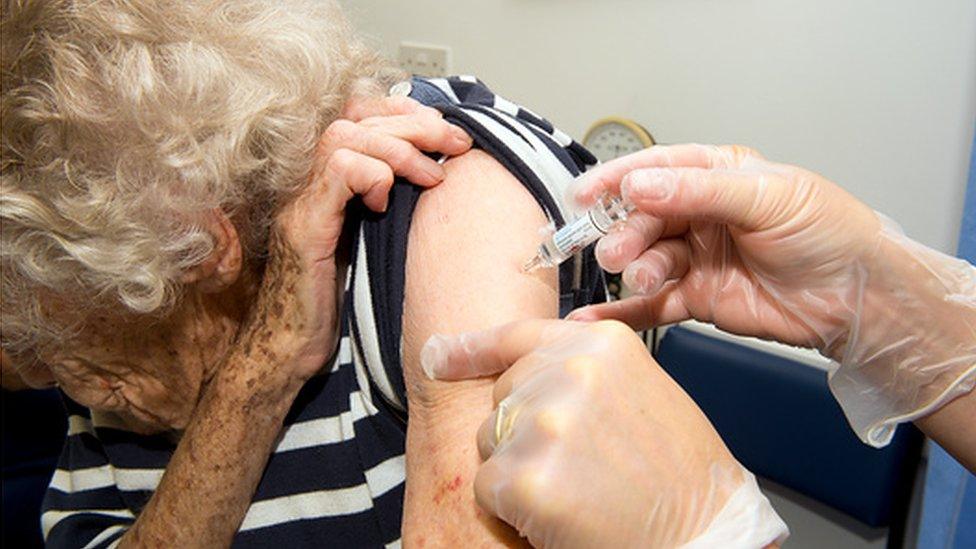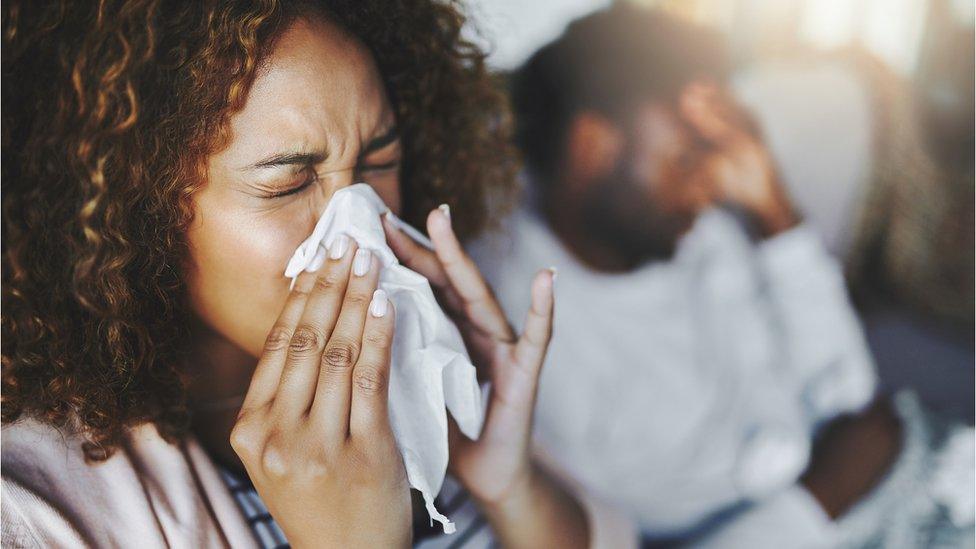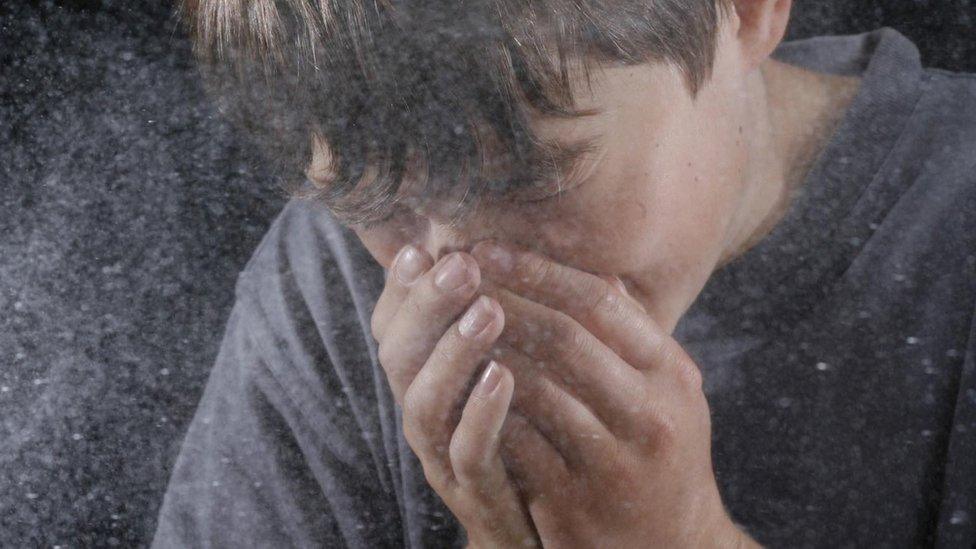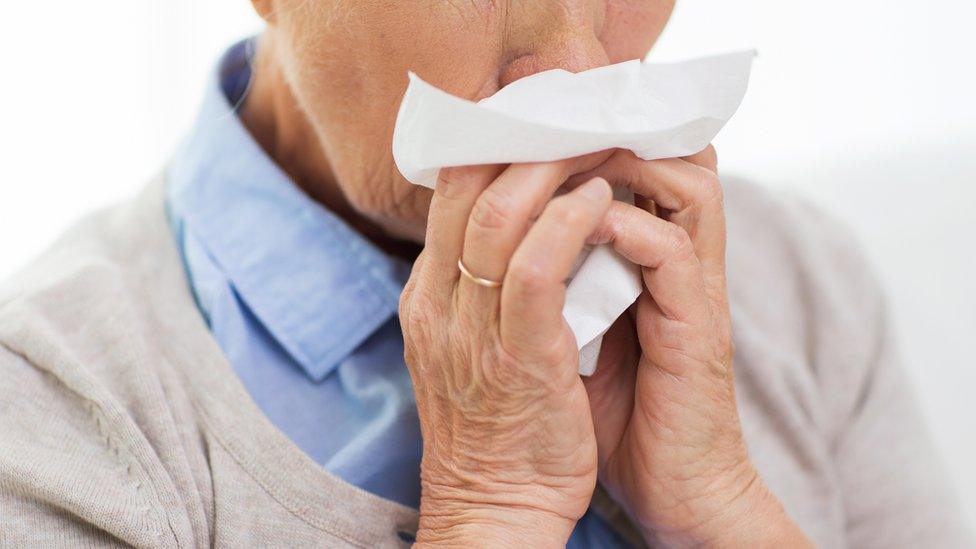Winter flu: Should we expect the worst?
- Published

Each flu season is different and very difficult to predict but having a vaccine is still recommended
Now the flu season is upon us, should we expect the worst?
If speculation based on the recent flu outbreak in Australia is to be believed, then yes. But are these fears unfounded?
Australia has witnessed its worst flu outbreak for over a decade - more than twice the usual level.
In most people, seasonal flu infection is unpleasant but relatively harmless. But for some - the elderly, very young and those with asthma, diabetes or heart disease - flu can prove fatal.
That's why we immunise against flu.
Current vaccines contain two different strains of influenza A and one or two strains of influenza B.
But there are lots of strains circulating around the world and these are constantly evolving.
This means that choosing which strains to use in the vaccine is not easy. This decision is left to a global network of scientists who painstakingly analyse thousands of viruses to try to second-guess which viruses will dominate.
Despite their best efforts, these predictions don't always work.
Have virus strains mutated?
According to Dr John McCauley, director of the WHO Collaborating Centre for Reference and Research on Influenza at the Crick Institute UK, one influenza A strain in particular has been causing some problems: "What happened to the H3N2 viruses, which have been with us ever since 1968, is that they've just kept evolving and changing.
"There's been an increased impact since new varieties came out in 2013-14 and I think we're still seeing their effects around the world."
Could the raised levels of flu activity seen in Australia over their winter months be because the H3N2 virus strains had mutated and were no longer similar to the vaccine strain?
Dr McCauley doesn't think so: "Is there any evidence for antigenic drift? The answer to that is marginal for this year and last year, whereas when these viruses first came along in 2013-14 that was clear-cut."
And that's a conundrum. The virus used in the vaccine should have protected, yet for some reason, in some parts of the world like Australia, it was failing.
This led scientists to question whether the way the vaccine was made was affecting its ability to generate virus-killing antibodies.
How is the vaccine made?
To make the adult vaccine, virus is grown in hen eggs but this can also lead to virus mutation.
And recent studies have suggested that antibodies raised by these mutant egg-grown H3N2 vaccine viruses are unable to kill viruses that are infecting humans.
But, as Dr McCauley pointed out, it isn't just down to the way the virus is grown: "For the attenuated vaccine, which is also grown in hens' eggs, the protection was good."

H3N2 is a type of influenza A virus currently circulating in humans
So it seems not so much how the virus is grown, but whether it is killed or attenuated.
For the killed virus we know that protection is associated with antibodies, but these target the virus proteins that mutate when the virus is grown in eggs.
Although we still don't fully understand how the attenuated vaccine works, we do know that this vaccine is able to stimulate another part of the immune system - the group of white blood cells known as killer T cells.
How could T cells help?
Sarah Gilbert, professor of vaccinology at Vaccitech Ltd and the Jenner Institute, University of Oxford, says T cells can be beneficial.
"The good thing is that T cells target proteins in the flu virus that are very well conserved, so we don't have the problem of the targets for the immune response constantly changing, but the challenge is to bring the flu-targeting T-cells back up to levels that are protective."
The theory goes that immunity arising from T cells won't be affected by mutations that occur during natural evolution of the virus or when the virus is grown in eggs.
Prof Gilbert and her team have just embarked on a clinical trial that uses a safe version of the smallpox vaccine to deliver influenza proteins in the hope that this will boost the level of flu-killing T cells and protect against infection.

The elderly and the very young are most at risk from flu
"It's a really good year to test our vaccine if the normal inactivated vaccine doesn't perform as well as hoped," Prof Gilbert told BBC News.
The scientists hope that the additional vaccine component will work its magic in three ways - by raising T cells that target parts of the virus less likely to mutate, by increasing the number of strains that can be targeted by antibodies raised by the standard vaccine and also by increasing the amount of antibody produced.
But what of the forthcoming flu season - should we brace ourselves for an upturn in cases?
If I were a betting man, and given what we have just witnessed in Australia, then I would say the chances are high. However, each flu season is different and very difficult to predict.
What I can say though, with absolute confidence, is that before every flu season it is extremely important for those most at risk to get immunised.
What are influenza viruses?
Influenza exists as distinct flavours of virus - influenza type A, B and C. Type A is usually the most serious while type C is usually a mild infection experienced during childhood.
Influenza A can be further divided into subtypes; each is defined by the pairing of proteins that they carry on their surface. These surface proteins are called H and N antigens and are the targets for your antibody response.
As each new protein was discovered, it was assigned a number. So far we have identified 18 H and 11 N proteins, and every virus carries one type of H and N on its surface.
Not all of these HN types are found in viruses that infect humans; most are found in birds and other animals.
Influenza pandemics occur when a new subtype of influenza emerges from this very large animal reservoir. They can result in lots of disease and deaths, but fortunately these events are rare.
Currently there are two main subtypes of influenza A circulating in humans. The H1N1 swine flu emerged from pigs in 2009. H3N2 has been around since 1968.
As the virus passes from person to person they mutate and we call this process drift. If these mutations drastically affect antibody binding then we call it antigenic drift.
Antigenic drift can affect how well seasonal flu vaccines work.
There are two types of vaccine licensed for use in the UK - a killed vaccine, which is typically used in adults, and a live, attenuated, virus used in children.
- Published13 September 2017

- Published12 September 2017

- Published1 September 2017
